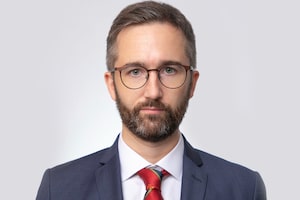
Sri Lankan soldiers stand guard near the parliament building in Colombo, on July 14.-/AFP/Getty Images
Days after protesters stormed Sri Lanka’s presidential palace, forcing the country’s leader to flee into exile, what remains of the government is trying to take control of an unstable situation.
Troops could be seen on the streets of the capital and stationed outside parliament Thursday, but demonstrators relinquished the government buildings they had seized, briefly bringing a tenuous calm to a country in both economic meltdown and political limbo.
Hours after fleeing to Singapore, President Gotabaya Rajapaksa submitted a letter of resignation, according to a spokesperson for the parliamentary speaker. Sent by e-mail late Thursday, the letter will become official Friday, once the document has been legally verified.
The announcement elicited celebrations in Colombo, where protesters gathered outside the presidential secretariat, defying the curfew in place until 5 a.m. Friday.
The troops outside parliament arrived in armoured personnel carriers to enforce the curfew, after a group attempted to storm the entrance the previous day and clashed with police, who fended them off with tear gas and batons.
On Wednesday, Prime Minister Ranil Wickremesinghe declared a state of emergency and called on the army to do “whatever is necessary to restore order” after protesters broke through police lines and stormed his office.
“We can’t tear up our constitution. We can’t allow fascists to take over. We must end this fascist threat to democracy,” he said in a televised address.
His level of control over the armed forces is unclear, however. Field Marshal Sarath Fonseka, a former commander of the Sri Lankan army who is now an opposition parliamentarian, urged soldiers to “refrain from following the unconstitutional orders given by Ranil Wickremesinghe.”
“I urge you not to target unarmed civilians but raise your weapons against corrupt politicians,” he said in a statement.
Mr. Fonseka had called on the country’s two top politicians to resign, saying Mr. Wickremesinghe and Mr. Rajapaksa would be held responsible if the protest movement “grows into a violent public rebellion.”
Police said one person was killed and 84 injured in the clashes Wednesday, while the army accused protesters of attacking soldiers and attempting to steal weapons.
Mr. Wickremesinghe was made acting president after Mr. Rajapaksa and his wife originally fled to the Maldives aboard an air force jet. They then travelled on to Singapore Thursday aboard a Saudia flight, a person familiar with the situation told Reuters.
Protesters had been calling for his resignation for months, blaming him for the country’s current economic disaster. Sri Lanka owes billions of dollars to foreign lenders and is facing major fuel and food shortages.
In May, Mr. Rajapaksa fired his brother Mahinda as prime minister and replaced him with Mr. Wickremesinghe, an opposition leader who promised to form a unity government to find a way out of the country’s financial morass.
But protesters continued to demand that Mr. Rajapaksa leave as well, and last week they stormed the presidential palace, occupying the building and threatening further unrest should their demands not be met.
Mr. Wickremesinghe said he would also resign, but only once a new government was in place.
“We want Ranil to go home,” protester Malik Perera told Reuters Thursday. “They have sold the country. We want a good person to take over. Until then we won’t stop.”
Sri Lankan lawmakers have agreed to elect a new president on July 20 to serve the remainder of Mr. Rajapaksa’s term, which ends in 2024. That person could potentially appoint a new prime minister, who would then have to be approved by parliament.
The political impasse threatens to worsen Sri Lanka’s economic collapse, as the absence of an alternative government could delay a hoped-for bailout from the International Monetary Fund. In the meantime, the country is relying on limited aid from India and China.
With files from Reuters and The Associated Press.
Our Morning Update and Evening Update newsletters are written by Globe editors, giving you a concise summary of the day’s most important headlines. Sign up today.
 James Griffiths
James Griffiths